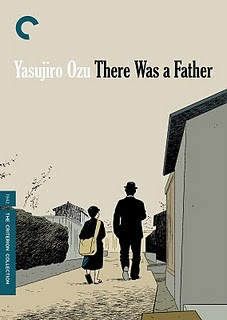It’s one of the best and most natural aesthetic marriages imaginable: The nuanced, meditative Japanese filmmaker Yasujiro Ozu and the nuanced, meditative comics Adrian Tomine, best known for the Optic Nerve series.
 Tomine has designed some covers for Ozu’s lesser known films, The Only Son and There Was a Father. Here is more info on the films, which the Criterion Collection will release next week. I love Ozu’s films — especially Tokyo Story and the season films like Late Spring, which date from the late ’40s to early ’60s — but must admit I have not yet seen either of these two.
Tomine has designed some covers for Ozu’s lesser known films, The Only Son and There Was a Father. Here is more info on the films, which the Criterion Collection will release next week. I love Ozu’s films — especially Tokyo Story and the season films like Late Spring, which date from the late ’40s to early ’60s — but must admit I have not yet seen either of these two.
Ozu’s films are known for their quiet tone, their emotional poignance, the low setting of the camera and the lack of conventional cutting. Some of them look at the tearing of family and traditional society.
I’ve written about Tomine — who grew up in Sacramento and lived in Berkeley for years before a recent move to Brooklyn — several times; this is the first and most complete. This week The Misread City spoke to him about the Ozu project.
 A few years ago you wrote your first Optic Nerve with an explicitly Japanese-American theme, and you’ve helped to recover the comics of the Japanese artist Tatsumi… Do you think you see and hear Ozu differently because of your Asian roots?
A few years ago you wrote your first Optic Nerve with an explicitly Japanese-American theme, and you’ve helped to recover the comics of the Japanese artist Tatsumi… Do you think you see and hear Ozu differently because of your Asian roots?
I’m also making slow progress on another, more “real” book, which will most likely be serialized in several issues of Optic Nerve before being re-packaged as a “graphic novel.” But like I said, progress is moving slowly, especially now that I’ve got an 8-month-old daughter and I’m constantly running out of my studio to either change a shitty diaper or watch her do something cute.
Art courtesy Adrian Tomine

I have seen every surviving Ozu film (many have been lost to time) thanks to a dual film series at Film Forum and Lincoln Center during the 90s. I almost always ended up seated behind Susan Sontag (RIP), who was clearly also a big Ozu fan. I would eavesdrop on her conversations with her friends in hopes of overhearing something really fascinating and intellectual, but never did. Mostly I just marveled at her hair.
I plan on picking up this set. Both of these films are absolutely marvelous. Criterion also has a set of three Ozu silent films available in their Eclipse series, including I Was Born But… which is probably my favorite of his films. They also have a very nice set that includes both the silent and sound versions of Floating Weeds.
Kudos to Criterion for putting these films out because they deserve to be seen more in the West than they have been. Also kudos for the great artwork, which I agree matches Ozu’s aesthetic perfectly.
And Scott, kudos to you for the great interview.
海鷗要高飛,必先遠退。花蜜要香醇,必先久釀。............................................................